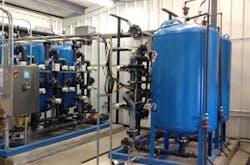In late 2000, the village of Clarks in central Nebraska was alerted that the water from its public drinking water system contained uranium levels of more than 200 ppb, which far exceeded the proposed U.S. Environmental Protection Agency’s (EPA) Maximum Contaminant Limit (MCL) of 30 ppb. In 2005, the village received an administrative order from the Nebraska Department of Health and Human Services for non-compliance with the new uranium MCL. As a result, free bottled water has been provided to village residents.
Clarks is served by two wells controlled by variable frequency drives providing a combined flow rate of 200 gal per min (gpm). Water is pumped to a distribution system, which includes a 50,000-gal atmospheric elevated water storage tank. In order to comply with the state of Nebraska drinking water regulations, the village of Clarks needed to enhance its existing water system.
Miller & Associates Consulting Engineers P.C., based in Kearney, Neb., completed an extensive evaluation of treatment technologies to reduce uranium, as well as secondary contaminants including iron and manganese. As a result, the village of Clarks contracted with AdEdge Water Technologies LLC to design and manufacture a two-stage packaged water treatment system capable of reducing iron, manganese and uranium concentrations in its water supply wells to achieve the EPA drinking water MCLs.
“Due to the uranium concentrations and administrative order, the project was under a short timeline to return to compliance. Pre-purchasing the packaged water treatment equipment from AdEdge was a process which helped expedite the design of the entire water treatment plant,” said Dana Peterson, design engineer for Miller & Associates.
Treatment Solution
AdEdge engineers designed a 200-gpm packaged treatment solution that included an AdEdge Model AD26-3660CS-S-3-AVH oxidation/filtration system featuring AdEdge AD26 media, followed by an AD92-4260CS-S-2-AVH uranium removal system featuring AdEdge AD92 IX media. AD26 media is NSF certified for drinking water and is specifically designed to remove iron and manganese in groundwater supplies. AD92 IX media is a selective anion exchange resin used to remove naturally occurring uranium from groundwater.
The AD26 and AD92 units are controlled by a common Allen Bradley Micrologix 1500 programmable logic controller (PLC) in a single NEMA 4X stainless steel enclosure mounted on the AD26 skid. A Panel View color-touch screen allows easy access by the operator for automatic and manual control and monitoring of the filtration cycles. Backwashing (delivered from treated water storage) occurs regularly in the system, primarily to remove suspended or precipitated material from the beds and also to prevent excessive pressure loss from the system to maintain efficient contaminant removal.
System Performance
The system was started up on January 11, 2012. A report of the first four weekly effluent samples indicated that the source water influent uranium levels ranging in the 70 to 80+ µg/L range are being treated, so all four are below the Minimum Detection Level, taking almost all of the uranium out of the source water. A letter from the Monitoring and Compliance Section of the Nebraska Public Drinking Water Program recently was sent to village board members stating that the village may immediately cease providing alternate water for the purposes of drinking and cooking.
“Not only are uranium concentrations below the detection limit, the iron and manganese concentrations in the treated effluent are also very low. The water customers have commented that the water tastes better and does not stain as it did in the past. The AdEdge treatment equipment is the heart of the treatment plant and is performing as expected,” Peterson said.


